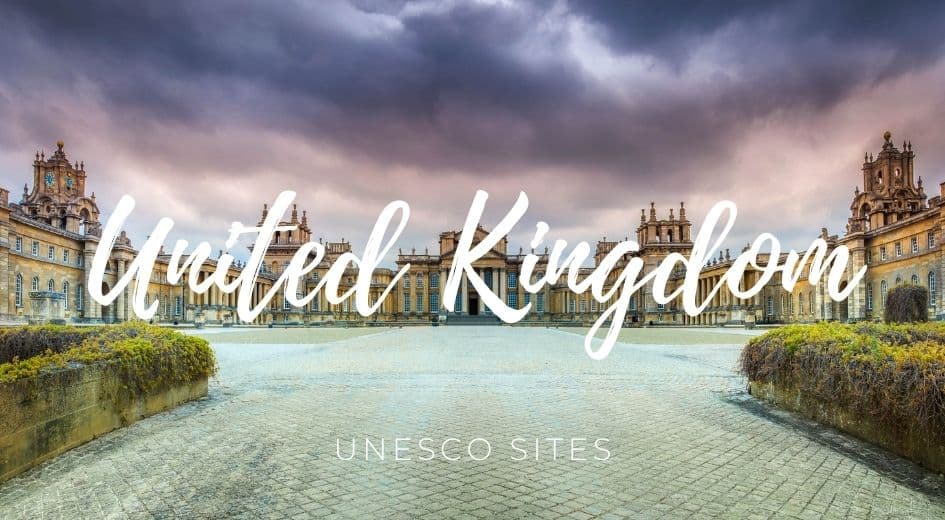Table of Contents


United Kingdom UNESCO has registered 33 sites on the World Heritage list and 9 on the tentative list.
Some places are so interesting that it’s relevant to keep them for future generations. This is why UNESCO has built a list of crucial classified properties in which superb places stand out for their aesthetic, natural, artistic, or cultural significance.
More than a thousand places are registered as Unesco’s World Heritage worldwide. Due to my interest in visiting World Heritage sites, I compiled the UNESCO list in the United Kingdom and the corresponding map.
United Kingdom UNESCO list
- Blaenavon Industrial Landscape
- Blenheim Palace
- Canterbury Cathedral, St Augustine’s Abbey, and St Martin’s Church
- Castles and Town Walls of King Edward in Gwynedd
- City of Bath
- Cornwall and West Devon Mining Landscape
- Derwent Valley Mills
- Durham Castle and Cathedral
- Frontiers of the Roman Empire
- Gorham’s Cave Complex
- Heart of Neolithic Orkney
- Historic Town of St George and Related Fortifications, Bermuda
- Ironbridge Gorge
- Jodrell Bank Observatory
- Maritime Greenwich
- New Lanark
- Old and New Towns of Edinburgh
- Palace of Westminster and Westminster Abbey including Saint Margaret’s Church
- Pontcysyllte Aqueduct and Canal
- Royal Botanic Gardens, Kew
- Saltaire
- Stonehenge, Avebury and Associated Sites
- Studley Royal Park including the Ruins of Fountains Abbey
- The English Lake District
- The Forth Bridge
- The Great Spa Towns of Europe
- The Slate Landscape of Northwest Wales
- Tower of London
- Dorset and East Devon Coast
- Giant’s Causeway and Causeway Coast
- Gough and Inaccessible Islands
- Henderson Island
- St Kilda
United Kingdom UNESCO Map
Click on the blue pins to view more relevant information about each World Heritage site in the United Kingdom.
Description
- Blaenavon Industrial Landscape: is in South Wales. It is known for its well-preserved industrial landscape, which includes former ironworks, a coal mine, and a railway.
- Blenheim Palace: is in Oxfordshire, England. It was built in the early 18th century and is known for its well-preserved Baroque architecture and beautiful gardens. It is recognized as a UNESCO World Heritage Site.
- Canterbury Cathedral, St Augustine’s Abbey, and St Martin’s Church: are three historic sites in Canterbury, England. They are known for their well-preserved medieval architecture and are recognized as a UNESCO World Heritage Site.
- Castles and Town Walls of King Edward in Gwynedd: is a group of well-preserved medieval castles and fortifications in north Wales. They were built in the 13th century and are recognized as a UNESCO World Heritage Site.
- City of Bath: is a well-preserved Georgian city in Somerset, England. It is known for its well-preserved Georgian architecture, including the Roman Baths and the Royal Crescent, and is recognized as a UNESCO World Heritage Site.
- Cornwall and West Devon Mining Landscape: is in southwest England. It is known for its well-preserved mining heritage, including engine houses, mine chimneys, and other industrial structures.
- Derwent Valley Mills: is in Derbyshire, England. It is known for its well-preserved industrial heritage, including mills, warehouses, and worker housing.
- Durham Castle and Cathedral: are in Durham, England. It is known for its well-preserved Romanesque architecture and is one of Europe’s finest examples of Norman architecture.
- Frontiers of the Roman Empire: is a Site that spans several countries, including the United Kingdom. It includes the remains of the Roman wall that once marked the northern boundary of the Roman Empire.
- Gorham’s Cave Complex: is on Gibraltar’s island. It is known for its well-preserved evidence of human occupation over the last 125,000 years, including Neanderthal remains.
- Heart of Neolithic Orkney: is on the Orkney Islands, Scotland. It is known for its well-preserved Neolithic monuments, including the Standing Stones of Stenness, the Ring of Brodgar, and Skara Brae.
- Historic Town of St George and Related Fortifications, Bermuda: is in St. George’s, Bermuda. It is known for its well-preserved colonial architecture and fortifications.
- Ironbridge Gorge: is in Shropshire, England. It is known for its well-preserved industrial heritage, including the Iron Bridge, the world’s first cast iron bridge.
- Jodrell Bank Observatory: is in Cheshire, England. It is known for its contributions to developing radio astronomy and space research.
- Maritime Greenwich: it is in London, England. It is known for its well-preserved maritime history, including the Royal Observatory and the National Maritime Museum.
- New Lanark: it is in South Lanarkshire, Scotland. It is known for its well-preserved industrial village, built in the 18th century and considered a landmark in the history of urban planning.
- Old and New Towns of Edinburgh: it is in Edinburgh, Scotland. It is known for its well-preserved Georgian and medieval architecture, including the Royal Mile, Edinburgh Castle, and the New Town.
- Palace of Westminster and Westminster Abbey including Saint Margaret’s Church: is in London, England. It is known for its well-preserved Gothic architecture and historical significance as the site of British political power.
- Pontcysyllte Aqueduct and Canal: is in north Wales. It is known for its well-preserved aqueduct, built in the 18th century to transport coal and iron.
- Royal Botanic Gardens, Kew: is in London, England. It is known for its well-preserved botanical gardens and research facilities, home to over 50,000 plant species.
- Saltaire: is in West Yorkshire, England. It is known for its well-preserved model industrial village, built in the 19th century and considered a landmark in the history of urban planning.
- Stonehenge, Avebury, and Associated Sites: is in Wiltshire, England. It is known for its well-preserved Neolithic monuments, including Stonehenge and Avebury, which are among the world’s most famous and enigmatic prehistoric sites.
- Studley Royal Park including the Ruins of Fountains Abbey: is located in North Yorkshire, England. It is known for its well-preserved 18th-century water garden and the ruins of Fountains Abbey, a Cistercian monastery founded in the 12th century.
- The English Lake District: is in Cumbria, England. It is known for its well-preserved landscape, including mountains, lakes, and valleys, and has inspired poets and artists for centuries.
- The Forth Bridge: is in Scotland. It is known for its well-preserved Victorian engineering and is considered a landmark in the history of bridge building.
- The Great Spa Towns of Europe: is a Site that includes several spa towns in Europe, including Bath in England, Karlovy Vary in the Czech Republic, and Baden-Baden in Germany.
- The Slate Landscape of Northwest Wales: in North Wales. It is known for its well-preserved slate mining industry, significantly impacting the region’s social and economic development.
- Tower of London: it is in London, England. It is known for its well-preserved historic buildings, including the White Tower and the Crown Jewels, and has played a significant role in English history.
- Dorset and East Devon Coast: is in southern England. It is known for its well-preserved Jurassic coastline, which includes cliffs, beaches, and a variety of.
- Giant’s Causeway and Causeway Coast: is in Northern Ireland. It is known for its well-preserved natural landscape, including the unique hexagonal basalt columns that make up the Giant’s Causeway.
- Gough and Inaccessible Islands: is in the South Atlantic Ocean. It is known for its well-preserved wildlife, including seabirds and marine mammals, and its unique geological features.
- Henderson Island: is in the South Pacific Ocean. It is known for its well-preserved natural environment, unique flora and fauna, and archaeological significance as a site of human settlement.
- St Kilda: is a Site in the Outer Hebrides of Scotland. It is known for its well-preserved natural landscape and cultural significance as a former remote island community site.
UNESCO World Heritage Sites in United Kingdom have protected places for their cultural and natural importance.
Sites on the Tentative List
- Chatham Dockyard and its Defences
- Creswell Crags
- Darwin’s Landscape Laboratory
- Island of St Helena
- Mousa, Old Scatness and Jarlshof: the Zenith of Iron Age Shetland
- Flow Country
- The Twin Monastery of Wearmouth Jarrow
- Turks and Caicos Islands
- Moravian Church Settlements


